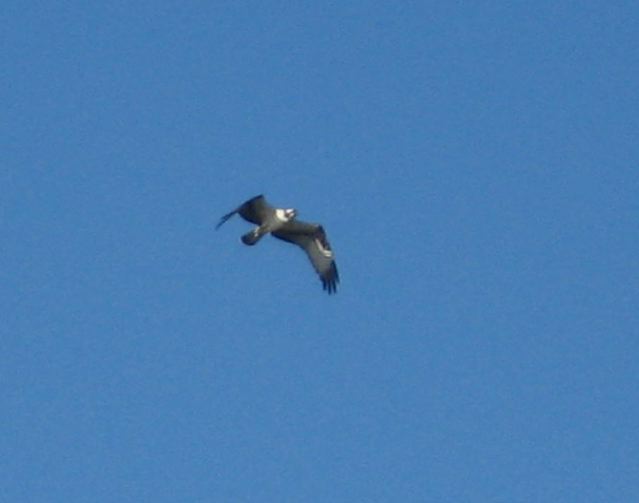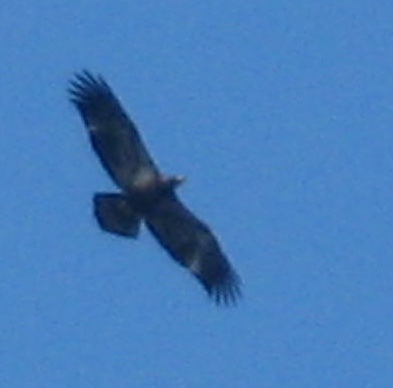Fall at Goldsmith Inlet
 There
are magical places that reveal nature's wonders to those who are there to
see it. Goldsmith's Inlet is such a place for me. Whether entering from the
trails off Soundview Ave., rambling along the shore off Mill Lane or
exploring the waters with rubber rowboat, canoe or kayak, there is always
something to see and wonder at. One warm fall day, my husband Rick and I
hauled our kayaks down to the Inlet at high tide (always the best time to
launch to avoid undue paddling against the current and to find enough water
to allow even such a shallow boat to float without scraping the sandy shoals
on the bed of the creek.) The intense blue sky and gold of beeches, yellow
of hickories and sassafras, and russet of oaks were an inspiration unto
themselves. The base of the Spartina grasses were still green but fingers of
yellow waved from their tips. Phragmites was turning brown in the
diminishing light of autumn. The water was clear, revealing herds of snails
crawling across the bottom. Not in evidence were the clams, oysters and
crabs of years gone by.
There
are magical places that reveal nature's wonders to those who are there to
see it. Goldsmith's Inlet is such a place for me. Whether entering from the
trails off Soundview Ave., rambling along the shore off Mill Lane or
exploring the waters with rubber rowboat, canoe or kayak, there is always
something to see and wonder at. One warm fall day, my husband Rick and I
hauled our kayaks down to the Inlet at high tide (always the best time to
launch to avoid undue paddling against the current and to find enough water
to allow even such a shallow boat to float without scraping the sandy shoals
on the bed of the creek.) The intense blue sky and gold of beeches, yellow
of hickories and sassafras, and russet of oaks were an inspiration unto
themselves. The base of the Spartina grasses were still green but fingers of
yellow waved from their tips. Phragmites was turning brown in the
diminishing light of autumn. The water was clear, revealing herds of snails
crawling across the bottom. Not in evidence were the clams, oysters and
crabs of years gone by.
 A gaggle of cormorants fished the far side. One stood on a rock, hanging
its wings to dry in the warm autumn sun. As we paddled closer, they took off
in a ragged line. Two Black Ducks followed, silvery-white underwings and
dark bodies identifying them.
A gaggle of cormorants fished the far side. One stood on a rock, hanging
its wings to dry in the warm autumn sun. As we paddled closer, they took off
in a ragged line. Two Black Ducks followed, silvery-white underwings and
dark bodies identifying them.
Overhead a large brown and white bird circled.
A late Osprey! It flew to the little pond beyond the footbridge, circled
again, dove and emerged with a Snapper. It flew off, searching for a branch
on which to perch and savor this little snack. A second Osprey flew over,
heading South. These are probably late migrators from the far north although
some males do remain in their breeding areas longer than females and young.
The mates and offspring of these birds might already be on their southern
wintering grounds. Some travel as far as the Brazilian basin, although most
remain in our own southern states or join the human sun-seekers in the
Caribbean.
 Suddenly, another, darker, larger bird flew overhead. Its
outstretched wings were flat, with "fingers " extending outward - An
immature Bald Eagle! an unusual, although not impossible sighting on
Eastern Long Island. Several have been spotted here in winter months,
usually immatures scavenging carrion, attesting to their lack of hunting
expertise. This one was developing some white at the base of the tail.
Probably a third year bird. Next spring it will display the white head and
tail of adulthood, if it can make it through the long winter months ahead.
Just as that bird flew southward another raptor soared low over the water.
It had a light body, dark wings and a dark cap and light line over the eye.
A large, chunky bird - a Goshawk! Another rarity arriving from the forests
of the far north - Northern New England, Canada, the Arctic. It too,
circled and then continued on its southern journey. Wow! Goldsmith Inlet
amazes once again. We now await its visiting winter ducks. As we paddled
back out to the mouth of the inlet, one of our winter guests was fishing
on the outgoing tide- A common Loon, still showing the ring around its neck
and some of the mottling of breeding plumage. It soon will be just dull
black and white and will remain with us until April or May when it will
return to its lake in the North Country. Common Loons are actually quite
common in the winter waters around Long Island and it is our privilege to
see this bird that will be much more elusive on its northern breeding
grounds. Come out and look. You never know when one of nature's miracles
will be there awaiting you at Goldsmith's Inlet.
Suddenly, another, darker, larger bird flew overhead. Its
outstretched wings were flat, with "fingers " extending outward - An
immature Bald Eagle! an unusual, although not impossible sighting on
Eastern Long Island. Several have been spotted here in winter months,
usually immatures scavenging carrion, attesting to their lack of hunting
expertise. This one was developing some white at the base of the tail.
Probably a third year bird. Next spring it will display the white head and
tail of adulthood, if it can make it through the long winter months ahead.
Just as that bird flew southward another raptor soared low over the water.
It had a light body, dark wings and a dark cap and light line over the eye.
A large, chunky bird - a Goshawk! Another rarity arriving from the forests
of the far north - Northern New England, Canada, the Arctic. It too,
circled and then continued on its southern journey. Wow! Goldsmith Inlet
amazes once again. We now await its visiting winter ducks. As we paddled
back out to the mouth of the inlet, one of our winter guests was fishing
on the outgoing tide- A common Loon, still showing the ring around its neck
and some of the mottling of breeding plumage. It soon will be just dull
black and white and will remain with us until April or May when it will
return to its lake in the North Country. Common Loons are actually quite
common in the winter waters around Long Island and it is our privilege to
see this bird that will be much more elusive on its northern breeding
grounds. Come out and look. You never know when one of nature's miracles
will be there awaiting you at Goldsmith's Inlet.






